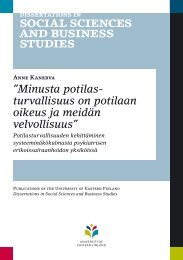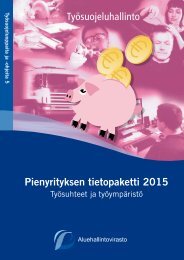urn_isbn_978-952-61-1770-6
urn_isbn_978-952-61-1770-6
urn_isbn_978-952-61-1770-6
- No tags were found...
You also want an ePaper? Increase the reach of your titles
YUMPU automatically turns print PDFs into web optimized ePapers that Google loves.
is significant, although inevitably the level of generality at which it is expressed orits centrality to the decision on the material facts of the case will affect its weightand influence. 120 The doctrine of stare decisis does not apply in the Convention system,and it follows that the doctrine of binding precedent (precedent de jure) mustbe rejected. 121 There is, however, a broad consensus that significant rulings by theECtHR on the interpretation and application of the Convention are generally followedin subsequent cases. 122The rules concerning precedent have to be viewed in the light of the ECtHR’sstructure. It is composed of five separate Chambers of equal standing and hasa Grand Chamber to which certain cases may be referred by a Chamber for initialdecision on the merits or for a re-hearing of a case decided initially by aChamber. 123 The Grand Chamber’s findings are regarded as more binding thanchamber judgments: a Grand Chamber ruling made by 17 judges is more authoritativethan one made by a Court Chamber. Further, the ECtHR marks the importanceof its judgments using a scale of importance from level 1 to 3, in whichimportance level 1 indicates that the judgment has high importance. 124The style of argumentation used by the ECtHR is lengthy and relatively complex,with pro and contra arguments in rather frequent use. Following previouscase law and arguing with the help of the established case law praxis at firstsight seems to resemble the common law tradition. 125 Furthermore, the use of dissentingopinions ensures that alternative arguments are articulated. 126 I regardtheir role as that of showing that the interpretation of the case could have takenanother direction and resulted in a different outcome. Dissenting opinions demonstratethat cases are not always easy to decide and that judges may very wellend up with two opposite conclusions. Judgments frequently run to tens of pagesbecause the facts of the case, and the domestic legislation and procedure, aredescribed in detail. However, the ECtHR’s main reasoning may fill just a coupleof paragraphs.The ECtHR’s argumentation as regards the alleged violation of a certainConvention provision generally commences with a brief explanation of the subject-matterof the complaint, followed by an evaluation of the admissibility of thecase. 127 After coming to the conclusion that the complaint is admissible, the mer-120Feldman 1999, at 114–115.121Balcerzak 2004/2005, at 139.122Mowbray 2009, at 183.123See Articles 30 and 43 of the Convention.124The ECtHR’s official website states that importance level 1 means that the judgment makes a significantcontribution to the development, clarification or modification of its case law, either generally or inrelation to particular state (http://www.echr.coe.int, visited on 5 November 2014).125In common law, the style of reasoning goes from details to generalities (inductive reasoning) andfrom facts to norms, while the logic applied by the ECtHR in its reasoning is somewhat different (andoften goes from the general to the particular), see e.g. Cook et al. 2001, at 58–60; van Poppel 2009, at139; Eisenberg 2007.126On separate opinions of the ECtHR, see e.g. White – Boussiakou 2009; Roucounas 2011. Letsashas argued that the ECtHR’s jurisprudence is undoubtedly closer to the common law style than theContinental style and that this is illustrated especially in separate opinions (Letsas 2011, at 306–309).127On the admissibility criteria, see Article 35 of the Convention.31




